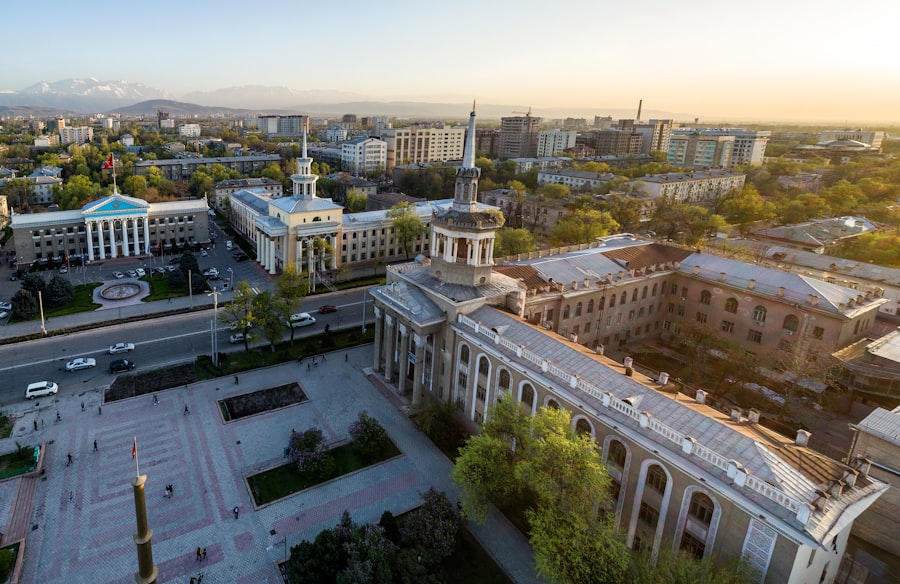Nestled in the heart of Central Asia, Kyrgyzstan is a country that often goes unnoticed by travelers. However, those who do venture to this hidden gem are rewarded with a wealth of cultural richness, natural wonders, and unique experiences. From its diverse cultural influences to its stunning landscapes, Kyrgyzstan offers a truly unforgettable travel experience.
Summary
- Kyrgyzstan offers hidden treasures waiting to be discovered by adventurous travellers.
- The country’s cultural richness is a unique blend of Eastern and Western influences.
- Exploring Kyrgyzstan’s natural wonders is a must for outdoor enthusiasts.
- The Silk Road legacy can be traced through the historical routes of Kyrgyzstan.
- Experiencing the nomadic traditions of the Kyrgyz people is a one-of-a-kind experience.
The Cultural Richness of Kyrgyzstan: A Blend of East and West
Kyrgyzstan is a melting pot of cultures, with influences from both the East and the West. The country’s history is marked by the Silk Road trade route, which brought merchants and travelers from all over the world. As a result, Kyrgyzstan has a rich tapestry of cultural influences, including Persian, Chinese, Russian, and Turkish.
Visiting historical sites and museums is a great way to delve into Kyrgyzstan’s cultural heritage. The capital city of Bishkek is home to several museums that showcase the country’s history and art. The State Historical Museum provides an in-depth look at Kyrgyzstan’s past, while the Museum of Fine Arts displays a collection of traditional and contemporary artwork.
For those interested in experiencing traditional music and dance performances, Kyrgyzstan offers a vibrant cultural scene. Traditional music is characterized by the use of traditional instruments such as the komuz (a three-stringed instrument) and the kyl-kyiak (a two-stringed instrument). Dance performances often feature intricate choreography and colorful costumes, showcasing the country’s rich cultural traditions.
The Natural Wonders of Kyrgyzstan: Exploring the Great Outdoors
One of the biggest draws for travelers to Kyrgyzstan is its stunning natural landscapes. The Tien Shan Mountains dominate the country’s skyline, offering endless opportunities for hiking and trekking. The Ala Archa National Park, located just outside of Bishkek, is a popular destination for outdoor enthusiasts. The park is home to several hiking trails that lead to breathtaking mountain vistas.
Another must-visit destination in Kyrgyzstan is Issyk-Kul Lake, one of the largest alpine lakes in the world. The lake is surrounded by snow-capped mountains and offers a range of water sports activities, including swimming, kayaking, and sailing. The lake’s unique microclimate also makes it a popular destination for beachgoers, with warm temperatures and sandy shores.
In addition to the mountains and lakes, Kyrgyzstan is also home to several national parks and nature reserves. The Sary-Chelek Biosphere Reserve is a UNESCO World Heritage Site and is known for its diverse flora and fauna. The Chon-Kemin Valley, located in the northern part of the country, offers stunning views of the surrounding mountains and is a great place for horseback riding and camping.
The Silk Road Legacy: Tracing the Historical Routes of Kyrgyzstan
| Route | Distance (km) | Duration (days) | Main Trade Goods |
|---|---|---|---|
| Chui Valley Route | 400 | 14 | Horses, Textiles, Carpets |
| Fergana Valley Route | 300 | 10 | Silk, Spices, Tea |
| Tien Shan Route | 500 | 21 | Jade, Precious Stones, Metals |
| Pamir Route | 800 | 30 | Wool, Furs, Salt |
Kyrgyzstan played a significant role in the ancient Silk Road trade network, which connected China to Europe. Tracing the historical routes of the Silk Road is a fascinating way to learn about Kyrgyzstan’s history and culture. The city of Osh, located in southern Kyrgyzstan, was an important trading hub along the Silk Road. Today, visitors can explore the city’s historic bazaars and caravanserais, which were once bustling with merchants from all over the world.
Another must-visit destination along the Silk Road is the city of Karakol. This charming town is home to several ancient ruins and monuments, including the Dungan Mosque and the Holy Trinity Orthodox Church. The city also serves as a gateway to the stunning Altyn Arashan Valley, where visitors can soak in natural hot springs surrounded by snow-capped mountains.
Nomadic Traditions: Experiencing the Unique Lifestyle of Kyrgyz People
Kyrgyzstan has a rich nomadic heritage, and visitors have the opportunity to experience this unique lifestyle firsthand. Staying in yurts, traditional nomadic dwellings, is a popular way to immerse oneself in Kyrgyz culture. Yurt camps can be found throughout the country, offering visitors a chance to sleep under the stars and experience traditional nomadic hospitality.
In addition to staying in yurts, visitors can also learn about traditional crafts and skills. Kyrgyz people are known for their skill in felt-making, and many artisans offer workshops where visitors can learn how to make traditional felt products. Other traditional crafts include weaving, embroidery, and wood carving.
Participating in cultural festivals and events is another way to experience Kyrgyzstan’s nomadic traditions. The country celebrates several cultural festivals throughout the year, including Nooruz, the Persian New Year, and Kurmanjan Datka, a celebration of the country’s national heroine. These festivals often feature traditional music and dance performances, as well as horseback riding and other traditional games.
Kyrgyz Cuisine: Savoring the Flavors of Central Asia

Kyrgyz cuisine is a delicious blend of Central Asian flavors, with influences from neighboring countries such as Kazakhstan, Uzbekistan, and China. Traditional dishes often feature meat, such as lamb or beef, as well as dairy products and breads.
One of the most famous dishes in Kyrgyz cuisine is beshbarmak, which translates to “five fingers” in English. This dish consists of boiled meat (usually lamb or beef) served on a bed of flat noodles and topped with onions. Another popular dish is lagman, a noodle soup that is often flavored with spices and vegetables.
Kyrgyzstan is also known for its dairy products, particularly kymyz, a fermented mare’s milk that is considered a national drink. Other popular dairy products include kurut, dried yogurt balls, and suzma, a type of strained yogurt.
Tea is an important part of Kyrgyz culture, and the country has a rich tea-drinking tradition. Traditional Kyrgyz tea is served in small bowls and is often accompanied by sweets and snacks. The tea is typically brewed with black or green tea leaves and flavored with herbs such as mint or thyme.
Festivals and Celebrations: Embracing Kyrgyzstan’s Vibrant Culture
Kyrgyzstan is a country that loves to celebrate, and visitors have the opportunity to join in on the festivities. One of the most important cultural festivals in Kyrgyzstan is Nooruz, which marks the arrival of spring. This festival is celebrated with music, dance, and traditional games, such as kok-boru, a traditional horseback game.
Another important festival in Kyrgyzstan is Kurmanjan Datka, which celebrates the country’s national heroine. Kurmanjan Datka was a powerful leader who played a key role in uniting the Kyrgyz people during the 19th century. The festival includes traditional music and dance performances, as well as horseback riding and other traditional games.
Traditional dress is an important part of Kyrgyz culture, and visitors can learn about the different styles and customs associated with traditional dress. The country’s national costume, known as the chapan, is often worn during special occasions and festivals. The chapan is a long robe made of wool or silk and is often adorned with intricate embroidery.
Adventure Tourism: Thrilling Activities in the Heart of Central Asia
For adrenaline junkies, Kyrgyzstan offers a wide range of adventure activities in its stunning natural landscapes. The Tien Shan Mountains are a paradise for rock climbers and mountaineers, with several challenging peaks to conquer. Peak Lenin, located in the Pamir Mountains, is one of the most popular climbing destinations in the country.
In winter, Kyrgyzstan transforms into a winter wonderland, with several ski resorts offering world-class skiing and snowboarding. The Karakol Ski Resort, located near the city of Karakol, is one of the most popular ski resorts in the country. The resort offers a range of slopes for all skill levels, as well as equipment rental and ski lessons.
For those who prefer water sports, Kyrgyzstan’s lakes and rivers offer plenty of opportunities for rafting and kayaking. The Chon-Kemin River, located in the Chon-Kemin Valley, is a popular destination for white-water rafting. The river offers a range of rapids, from gentle Class I to challenging Class
Sustainable Tourism: Promoting Responsible Travel in Kyrgyzstan
As tourism continues to grow in Kyrgyzstan, it is important to promote responsible travel practices to ensure the long-term sustainability of the country’s natural and cultural resources. Responsible tourism practices include supporting local communities and businesses, minimizing environmental impact, and participating in eco-friendly activities and tours.
One way to support local communities is by staying in locally-owned accommodations, such as guesthouses or yurt camps. These accommodations provide income for local families and allow visitors to experience traditional Kyrgyz hospitality. Buying locally-made products and souvenirs is another way to support local businesses.
Minimizing environmental impact can be achieved by practicing Leave No Trace principles, such as packing out trash and respecting wildlife and natural habitats. Participating in eco-friendly activities and tours, such as hiking or horseback riding, can also help minimize environmental impact.
Kyrgyzstan – The Best-Kept Secret of Central Asia
In conclusion, Kyrgyzstan is a country that offers a wealth of hidden treasures for adventurous travelers. From its diverse cultural influences to its stunning natural landscapes, Kyrgyzstan has something to offer every type of traveler. Whether you’re interested in exploring historical sites, experiencing nomadic traditions, or indulging in delicious cuisine, Kyrgyzstan is sure to leave a lasting impression. So why not consider adding this best-kept secret of Central Asia to your travel bucket list?
FAQs
What is Kyrgyzstan?
Kyrgyzstan is a country located in Central Asia. It is bordered by Kazakhstan to the north, Uzbekistan to the west, Tajikistan to the southwest, and China to the east.
What is the capital of Kyrgyzstan?
The capital of Kyrgyzstan is Bishkek.
What is the population of Kyrgyzstan?
As of 2021, the estimated population of Kyrgyzstan is around 6.5 million people.
What is the official language of Kyrgyzstan?
The official language of Kyrgyzstan is Kyrgyz. Russian is also widely spoken and recognized as an official language.
What is the currency of Kyrgyzstan?
The currency of Kyrgyzstan is the Kyrgyzstani som.
What is the religion of Kyrgyzstan?
The majority of the population in Kyrgyzstan is Muslim, with a significant minority practicing Russian Orthodox Christianity.
What are the major industries in Kyrgyzstan?
The major industries in Kyrgyzstan include agriculture, mining, and textiles. The country is also known for its production of gold and other minerals.
What are some popular tourist attractions in Kyrgyzstan?
Some popular tourist attractions in Kyrgyzstan include Lake Issyk-Kul, Ala Archa National Park, and the Tien Shan Mountains. The country is also known for its traditional yurt camps and horseback riding tours.


